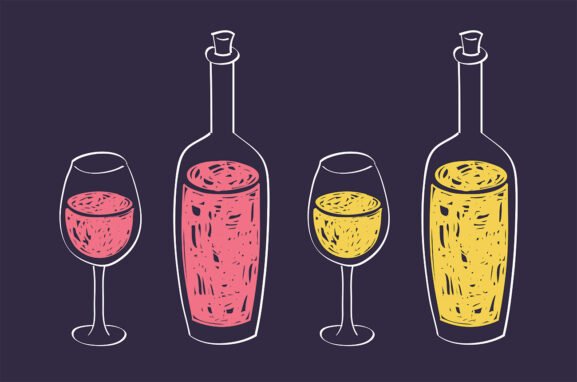How to Pair Japanese Food with Wine
One might assume that Japanese food should be paired with sake, beer or whiskey—all beverages well entrenched in the island nation’s drinking scene. But the spectacular diversity of Japan’s culinary offerings opens the door to fantastic wine pairings, which can complement and enhance their complexity of flavor and texture. Whether you’re eating tonkatsu ramen on the island of Kyushu or going on a takoyaki crawl of Osaka, there’s a sensational wine to go with it.
We tapped wine experts with a deep love for Japanese food for their recommendations, which turned out to be just as varied as Japan’s cuisine. For example, Nobuhide Otsuka, a seasoned sommelier who oversees the beverage program at Sézanne in the Four Seasons Hotel Tokyo at Marunouchi, gravitates towards French wines, recommending softer, aged Pinot Noirs for dishes like agedashi tofu and flowery Alsatian Riesling for shrimp tempura. On the flip side, Kevin Reilly, director of wine and spirits at Fontainebleau Las Vegas, pairs umami-rich tonkatsu ramen with off-dry German Riesling or Spanish Rioja.
No matter what direction you choose—New or Old World, subtle or bold—these pairings prove that Japanese food is enhanced by a well-chosen pour. Here our suggested pairings, picked by the experts.
In the Shop
Elevate your culinary skills with our premium selection of cooking tools and tableware.
The Best Wine for Omakase: Red Burgundy or Blanc de Noir Champagne
Omakase is not a single dish, but rather a progression of bites dictated by the chef, most often featuring sushi. While omakases can vary greatly, there are certain things you can expect. Typically, an omakase progresses from lighter to richer, heavier fare, and you want your wines to reflect that. Dry white wines like Champagne and Chablis are safe bets for a progression of sashimi, but there’s lots of room for creativity.
Mayumi Kobayashi-Loye, sommelier at sushi master Edowan Yoshida’s Yoshino in New York City, offers a wine and sake pairing that echoes the culinary influences of the chef. “Chef Yoshida’s otsumami courses can range from traditional Japanese to courses that have French influences, so I lean towards pairing his French-influenced courses with Champagne or a white Burgundy,” she says.
For the sushi courses, Kobayashi-Loye encourages guests to pair his tuna, sourced from Toyosu Market’s prestigious auction, with a red Burgundy. “In my personal opinion, having the world’s top tuna is reason enough to celebrate, but pairing it with an incredible red Burgundy or an outstanding Blanc de Noir Champagne just takes it to the next level,” she says.
Of course, the styles of omakase, which literally means “I’ll leave it up to you” in Japanese, varies widely. At SUMI, a restaurant located at Janu Tokyo, chef-sommelier Tatsuya Fujimori likes to select standout wines from various regions of Japan, to serve “in harmony with the Japanese ingredients.”
For example, he pairs sea bream sashimi with a white wine made from koshu, a grape variety indigenous to Japan’s Yamanashi Prefecture. “It has a citrus flavor and refreshing acidity,” he says. “The savory taste that develops in the latter half of the wine complements the taste of sashimi.”
Wine Enthusiast recommends:

The Best Wine for Beef Udon: New World Pinot Noir
There are countless styles of beef udon, so you’ll want to pay attention to ingredients. “Every chef’s udon recipe is considered ‘ban ryu,’ meaning ‘10,000 ways,’” says Daniel Bennett, beverage director and sake sommelier at The Omakase Room and Sushi-san in Chicago. “The spectrum widens if you are torn between yaki udon or udon soup! Focus on the protein and the fact that the vegetables and herbs are piled high.”
But with any beef udon dish, “a New World Pinot Noir’s vibrant acidity acts like a chef’s knife and its dynamic fruit and tertiary qualities can blend into any culinary mosaic,” he says. He suggests a glass of 2020 RAEN Royal St. Robert Sonoma Coast Pinot Noir, which he feels “is as thoughtful as a chef’s family recipe.”
This particular style and bottles works because “this Pinot, with flavors of cherry compote turned cola, strawberry-like acidity and old-growth forest aromas plays rhythm to any beef udon solo,” he says.

The Best Wine for Agedashi Tofu: Aged Pinot Noir
Crispy cubes of tofu in a sweet and savory sauce calls for a wine pairing that won’t overpower it. “There is no need for strong wine for the light flavor of tofu,” says Otsuka. “The food itself is a dish where you can enjoy the taste of the ingredients, like the sweet bean flavor of tofu and the aroma of high-quality bonito stock.”
He gravitates towards a soft, very aged Pinot Noir “with a dashi-like aroma” to enhance the flavor of the soybeans. Also, the dish is often topped with bonito flakes, and “the aged aroma of bonito flakes and the aroma of aged Pinot Noir go well together.” He suggests a 1985 Arbois – Cuvée Special Pinot Noir Magnum – Domaine Rolet.

The Best Wine for Shrimp Tempura: Riesling, Chardonnay or Sancerre
The process of frying rich, crunchy shrimp tempura gently steams the shrimp inside of the batter, bringing out its sweet flavor. Otsuka suggests “a flowery Riesling or rich-acid Chardonnay that doesn’t have an oaky feel.” You want to find a wine that “nestles in with the richness of the oil and the sweetness of the shrimp.” He points to a 2021 Riesling Cuvee Theo – Domaine Weinbach or a 2018 Pouilly-Fuisse La Croix VV – Robertb Denogent.
A crisp Sancerre would be another lovely option, according to Kevin Reilly, director of wine and spirits at Fontainebleau Las Vegas. “A crisp, dry and mineral-driven white wine highlighted by grapefruit and fresh tarragon characteristics complement shrimps’ delicate flavor, but contrast the slightly salty and sweet batter,” he says.
Wine Enthusiast recommends:

The Best Wine for Takoyaki: Dry, Sparkling Riesling
A crispy, ball-shaped Japanese snack that’s often filled with octopus, rich takoyaki calls for something dry, cold and crisp. Kobayashi-Loye suggests pairing a dry, sparkling Riesling with the snack.
“Takoyaki is my absolute favorite street food,” she says. “If public drinking were allowed in New York City, I’d walk around the summer street festivals with an ice cold glass of Von Winning’s Riesling Sekt Extra Brut—a dry sparkling Riesling by one of my favorite producers—in one hand and a plate full of takoyaki with all of its glorious toppings in the other.”

The Best Wine for Kobe Beef: Right Bank Bordeaux or Vintage Rosé Champagne
David Bérubé, beverage director at l’abeille, l’abeille à côté and sushi ichimura in New York City, suggests two possible directions, both of which play up different attributes of the Kobe beef: a slightly-aged Right Bank Bordeaux, which is Merlot, or a vintage rosé Champagne.
With the Bordeaux, you can “play with the lushness and smoothness of the Merlot to match the impression of sweetness given by the beef while matching the fruit-wrapped tannins of the wine with the high marbling of the meat,” he says.
Alternatively, the more adventurous route of an aged rosé Champagne would “play with the umami flavors in the Kobe and the mushrooms notes that you often get on aged Champagnes,” he says. “It also never hurts to bring an element of freshness to a rich cut of meat with the natural acidity and moderate carbonation that one will find in such Champagne.”
Wine Enthusiast recommends:

Pol Roger 2018 Rosé Brut (Champagne)
There is still some youth in this Champagne. Its red fruits and balancing acidity and texture are finely poised, the wine showing its good percentage of Pinot Noir in the blend. It is already rich and will gradually move into greater maturity. Drink now for freshness or wait until at least 2026 for maturity. 94 Points — R.V.
$149
Wine.com

The Best Wine for Tonkatsu Ramen: German Riesling or Spanish Rioja
Yet again, you have an option to go red or white. Reilly proposes two different routes—the first being off-dry German Riesling because “the high acidity of this grape cuts through the flavor of rich fried pork,” he says. “Its light sweetness, highlighted by citrus and stone fruit characteristics, play well with full-flavored broth that may or may not have some spice and heat.”
But red could also work here—specifically, a Spanish Rioja. “Tempranillo’s sweet and tart red fruit characteristics and full-flavored American oak profile can contrast pork’s richness, but also complement the rich full-flavored broth,” he says.
Wine Enthusiast recommends:

The Best Wine for Pork Gyoza: Italian Pinot Noir
Kat Hawkins, wine director at Miru in Chicago, says that the rich, decadent flavors of a succulent pork gyoza “require something with more depth and concentration.” In particular, Pinot Noir, ideally from Italy.
“Any time pork is involved, you need a light-bodied red with lots of fruit flavor,” says Hawkins. “Pinot Noir in any fashion will do, but the Pinot Noirs from Italy are extremely exciting and well made. Rottenstiener Pinot Noir from Alto Adige is brilliant in color, depth and flavor and would be the perfect pairing.”
The Best Wine for Chicken Katsu: Jura Savagnin or Blanc de Blancs Champagne
Because this is a rich, deep-fried dish that requires even more oil than tempura, Otsuka advises finding a wine with significant body. He’d recommend a Savagnin (not to be confused with Sauvignon) from the Jura area of eastern France that is not oxidatively aged.
“The refreshing acidity and spices derived from Savagnion and hint of oak barrels make rich dishes easier to eat,” he says.
Of course, fried chicken and Champagne are beloved companions for a reason, and it’s Daniel Bennett’s favorite “high-low pairing.” He feels that “a thoughtful Blanc de Blancs Champagne is perfect,” he says. “Do yourself a favor and go millésime, or vintage, for impact.”
Wine Enthusiast recommends:

In the Shop
Organize and Display Your Wine in Style
Put an exceptional wine selection on display with decorative wine racks of every style, size, and placement for your home.
Published: June 6, 2024

